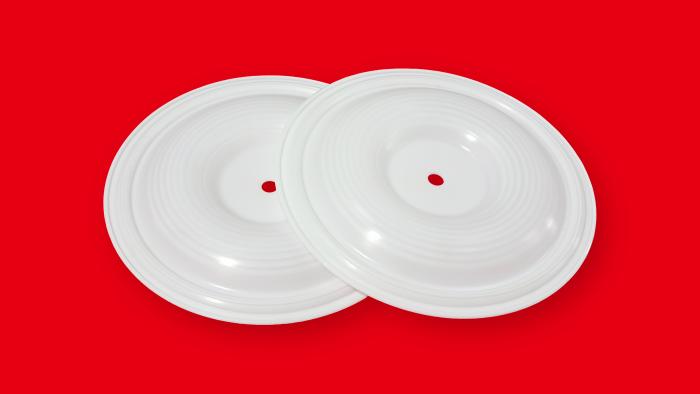咨询热线
电话:18925433252
手机:18925433252
座机:18925433252
邮箱:2954991375@qq.com
地址:广东省东莞市石碣镇横滘工业区伟业街4号
气动隔膜泵膜片密封圈设计与应用:材料设计、更换维护及性能寿命影响!
气动隔膜泵膜片密封圈设计与应用是隔膜泵性能和寿命的关键因素之一。东晟密封圈告诉您本文将从膜片的材料选择、设计要点、更换维护等方面探讨气动隔膜泵膜片密封圈设计与应用。
一、气动隔膜泵膜片材料选择:
气动隔膜泵膜片密封圈 通常由橡胶、聚四氟乙烯、聚酯等材料制成。这些材料具有一定的弹性和耐腐蚀性能,能够承受高压和高温。不同的材料具有不同的性能和适用范围,需要根据具体的工作条件和介质性质进行选择。
1、橡胶气动隔膜泵膜片;
橡胶膜片是隔膜泵常用的膜片材料之一,具有良好的耐腐蚀性能和耐磨性能,适用于输送中等浓度和低浓度的酸碱液、磨蚀性介质和食品等。常用的橡胶材料有氯丁橡胶、丁基橡胶、氟橡胶等。

2、聚四氟乙烯气动隔膜泵膜片;
聚四氟乙烯膜片是一种耐腐蚀性能极好的材料,能够承受极端的高温和强酸强碱介质,适用于输送强腐蚀性介质和高温介质。但由于其弹性较差,容易因受力而形变,不适用于输送颗粒较大的介质。此外,聚四氟乙烯膜片的价格较高,需要根据具体的工作条件和介质性质进行选择。
3、聚酯气动隔膜泵膜片;
聚酯膜片是一种价格较低、强度较高的材料,适用于输送中等浓度的酸碱液、食品等。但聚酯膜片的耐腐蚀性能较差,不适用于输送强酸强碱介质和高温介质。
二、气动隔膜泵膜片设计要点:
气动隔膜泵膜片密封圈
设计对泵的性能和寿命有着至关重要的影响。从膜片的厚度、形状、张力等方面进行设计和优化,能够提高隔膜泵的性能和寿命。
1、气动隔膜泵膜片厚度;
膜片的厚度直接影响到膜片的耐用性。一般而言,膜片越厚,耐用性就越好。但是,过于厚的膜片会影响泵的性能和效率,因此需要根据具体的工作条件和介质性质进行选择。
2、气动隔膜泵膜片形状;
膜片的形状也会影响到隔膜泵的性能和寿命。在设计膜片时需要考虑到泵的排量和性能要求,选择合适的形状和尺寸。一般而言,膜片的形状应尽量简单,避免过于复杂的形状和细节,以免影响膜片的强度和耐用性。
3、气动隔膜泵膜片张力;
膜片的张力对隔膜泵的性能和寿命也有着重要的影响。膜片的张力越大,泵的排量越大,但也会影响泵的效率和寿命。在设计和安装膜片时需要注意调整膜片的张力,确保膜片的位置和张力符合要求,避免泄漏和振动。
三、气动隔膜泵膜片更换维护:
气动隔膜泵膜片密封圈
使用寿命是直接影响到隔膜泵的运行时间和工作效率的重要因素之一。因此,在使用隔膜泵时需要定期检查和更换膜片,以确保泵的性能和寿命。
1、气动隔膜泵膜片更换周期;
膜片的更换周期需要根据具体的工作条件和介质性质进行确定。一般而言,膜片的使用寿命在6个月至1年左右。如果发现膜片出现裂纹、老化、变形等问题,需要及时更换膜片。
2、气动隔膜泵膜片更换注意事项——在更换膜片时需要注意以下几点;
(1)选择合适的膜片材料和规格;
(2)检查膜片接口和密封性能;
(3)调整膜片的张力和位置,确保符合要求;
(4)检查泵的其他部件是否存在损坏或磨损;
(5)根据隔膜泵的使用说明书进行操作。
总之,气动隔膜泵膜片密封圈设计与应用是隔膜泵性能和寿命的关键因素之一。正确选择膜片材料、设计合理的膜片形状和张力、定期检查和更换膜片,能够提高隔膜泵的性能和寿命,保证泵的正常运行。
以下英文版:
The design and application of diaphragm seals in pneumatic diaphragm pumps are one of the key factors affecting the performance and lifespan of diaphragm pumps. Qi Sheng Xincai tells you that this article will explore the design and application of diaphragm seals for pneumatic diaphragm pumps from the aspects of material selection, design points, replacement and maintenance.
l Selection of diaphragm material for pneumatic diaphragm pumps:
The diaphragm seals of pneumatic diaphragm pumps are usually made of materials such as rubber, polytetrafluoroethylene, polyester, etc. These materials have certain elasticity and corrosion resistance, and can withstand high pressure and high temperature. Different materials have different properties and applicability, and selection needs to be based on specific working conditions and medium properties.
1. Rubber pneumatic diaphragm pump diaphragm;
Rubber diaphragm is one of the commonly used diaphragm materials for diaphragm pumps, which has good corrosion resistance and wear resistance. It is suitable for transporting medium and low concentration acid and alkali liquids, corrosive media, and food. Commonly used rubber materials include chloroprene rubber, butyl rubber, fluororubber, etc.
2. PTFE pneumatic diaphragm pump diaphragm;
Polytetrafluoroethylene membrane is a material with excellent corrosion resistance, capable of withstanding extreme high temperatures and strong acidic and alkaline media, suitable for transporting highly corrosive and high-temperature media. However, due to its poor elasticity, it is prone to deformation due to stress and is not suitable for conveying media with larger particles. In addition, the price of polytetrafluoroethylene membranes is relatively high and needs to be selected based on specific working conditions and medium properties.
3. Polyester pneumatic diaphragm pump diaphragm;
Polyester film is a material with lower price and higher strength, suitable for conveying medium concentration acid and alkali liquids, food, etc. However, polyester membranes have poor corrosion resistance and are not suitable for transporting strong acid, alkali, and high-temperature media.
l Key points of diaphragm design for pneumatic diaphragm pumps:
The design of diaphragm seals in pneumatic diaphragm pumps has a crucial impact on the performance and lifespan of the pump. Designing and optimizing the thickness, shape, tension, and other aspects of the diaphragm can improve the performance and lifespan of the diaphragm pump.
1. Diaphragm thickness of pneumatic diaphragm pump;
The thickness of the diaphragm directly affects its durability. Generally speaking, the thicker the diaphragm, the better its durability. However, an excessively thick diaphragm can affect the performance and efficiency of the pump, so it needs to be selected based on specific working conditions and medium properties.
2. Diaphragm shape of pneumatic diaphragm pump;
The shape of the diaphragm also affects the performance and lifespan of the diaphragm pump. When designing the diaphragm, it is necessary to consider the displacement and performance requirements of the pump, and choose the appropriate shape and size. Generally speaking, the shape of the membrane should be as simple as possible to avoid overly complex shapes and details, in order to avoid affecting the strength and durability of the membrane.
3. Pneumatic diaphragm pump diaphragm tension;
The tension of the diaphragm also has an important impact on the performance and lifespan of the diaphragm pump. The greater the tension of the diaphragm, the greater the displacement of the pump, but it also affects the efficiency and lifespan of the pump. When designing and installing the diaphragm, attention should be paid to adjusting the tension of the diaphragm to ensure that the position and tension of the diaphragm meet the requirements, and to avoid leakage and vibration.
l Pneumatic diaphragm pump diaphragm replacement and maintenance:
The service life of diaphragm seals in pneumatic diaphragm pumps is one of the important factors that directly affect the operating time and efficiency of diaphragm pumps. Therefore, when using a diaphragm pump, it is necessary to regularly inspect and replace the diaphragm to ensure the performance and lifespan of the pump.
1. Pneumatic diaphragm pump diaphragm replacement cycle;
The replacement cycle of the diaphragm needs to be determined based on specific working conditions and medium properties. Generally speaking, the service life of the diaphragm is around 6 months to 1 year. If cracks, aging, deformation and other issues are found on the membrane, it is necessary to replace the membrane in a timely manner.
2. Precautions for replacing the diaphragm of pneumatic diaphragm pump - The following points need to be noted when replacing the diaphragm;
(1) Select appropriate diaphragm materials and specifications;
(2) Check the membrane interface and sealing performance;
(3) Adjust the tension and position of the diaphragm to ensure compliance with requirements;
(4) Check other components of the pump for damage or wear;
(5) Operate according to the operating manual of the diaphragm pump.
In summary, the design and application of diaphragm seals in pneumatic diaphragm pumps are one of the key factors affecting the performance and lifespan of diaphragm pumps. Proper selection of membrane materials, reasonable design of membrane shape and tension, regular inspection and replacement of membranes can improve the performance and lifespan of diaphragm pumps, and ensure their normal operation.
气动隔膜泵膜片密封圈,设计,应用,材料,气动隔膜泵膜片,隔膜泵膜片
泛塞密封圈-唇形密封圈-橡胶密封圈厂家-广东东晟密封圈 http://www.dshmfq.com/
咨询热线
18925433252